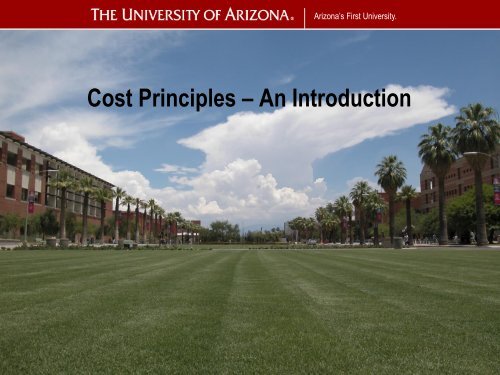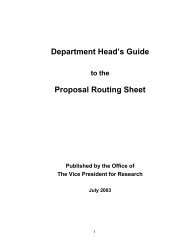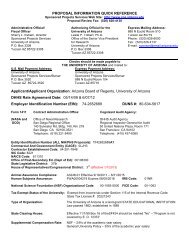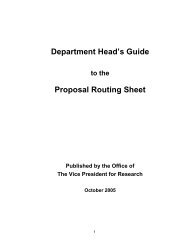Cost Principles – An Introduction - Sponsored Projects
Cost Principles – An Introduction - Sponsored Projects
Cost Principles – An Introduction - Sponsored Projects
Create successful ePaper yourself
Turn your PDF publications into a flip-book with our unique Google optimized e-Paper software.
Arizona’s First University.<br />
<strong>Cost</strong> <strong>Principles</strong> <strong>–</strong> <strong>An</strong> <strong>Introduction</strong>
Agenda<br />
• The Federal cost accounting pronouncements<br />
applicable to grants and contracts management<br />
• Codification of the pronouncements into law<br />
• <strong>Principles</strong> of cost accounting for higher education<br />
institution<br />
2
Federal Pronouncements<br />
• The White House Office of Management and Budget<br />
(OMB) provides guidance via pronouncements or Circulars<br />
to Federal agencies in formulating regulations applicable to<br />
Institutional Research Financial Activities<br />
• The following OMB Circulars apply to higher education<br />
<strong>–</strong> OMB Circular A-21: <strong>Cost</strong> <strong>Principles</strong> for Educational<br />
Institutions<br />
<strong>–</strong> OMB Circular A-110: Uniform Administrative Requirements<br />
for Grants and Agreements With Institutions of Higher<br />
Education, Hospitals, and Other Non-Profit Organizations<br />
<strong>–</strong> OMB Circular A-133: Audits of States, Local Governments,<br />
and Non-Profit Organizations<br />
3
Codification of OMB Circulars<br />
• OMB Circular A-21 and A-110 are codified in the Code of<br />
Federal Regulations (CFR)<br />
<strong>–</strong> A-21: 2 CFR PART 220<br />
<strong>–</strong> A-110: 2 CFR PART 215<br />
• Each agency determines its own regulations based on<br />
OMB Circular A-110. These regulations are then codified<br />
in the CFR. For example:<br />
<strong>–</strong> Regulations in 45 CFR 1-199 apply to the Department of<br />
Health and Human Services, General Administration<br />
<strong>–</strong> Regulations in 45 CFR 600-699 apply to the National Science<br />
Foundation.<br />
4
OMB Circular A-21<br />
• <strong>Cost</strong> principles for educational institutions<br />
• <strong>Principles</strong> for determining costs applicable to research and<br />
development, training, and other sponsored work<br />
• Apply to grants, contracts, and other agreements with the<br />
Federal Government<br />
• Prescribes government-wide policies on cost<br />
reimbursement<br />
<strong>–</strong> Uniform standards of cost allowability<br />
<strong>–</strong> Uniform standards of cost allocation<br />
• Assures the Federal Government bear its fair share of<br />
costs<br />
• Encourages consistent treatment of costs<br />
5
OMB Circular A-110<br />
• OMB Circular A-110 establishes uniform administrative<br />
requirements for Federal grants and agreements awarded<br />
to institutions of higher education, hospitals, and other<br />
non-profit organizations.<br />
• OMB Circular A-110 sets requirements in the following<br />
areas:<br />
<strong>–</strong> Pre-award<br />
<strong>–</strong> Post-award<br />
• Standards for financial management system<br />
• Payment<br />
• <strong>Cost</strong> sharing<br />
• Program income<br />
6
OMB Circular A-110 (Cont’d)<br />
<strong>–</strong> Post-Award (cont’d)<br />
• Revision of budget and program plans<br />
• Audit<br />
• Allowable costs<br />
• Period of availability of funds<br />
• Property Standards<br />
• Procurement Standards<br />
• Reports and Records<br />
<strong>–</strong> After-the-award: closeout etc.<br />
7
OMB Circular A-133<br />
• Sets forth standards for obtaining consistency and<br />
uniformity among Federal agencies for the audit of non-<br />
Federal entities expending Federal awards<br />
• Issued pursuant to the Single Audit Act of 1984 and the<br />
Single Audit Act Amendments of 1996<br />
• Non-Federal entities that expend $500,000 or more in a<br />
year in Federal awards shall have a single audit conducted<br />
for that year<br />
• The single audit or A-133 audit is an annual audit of all<br />
federally funded programs at an institution<br />
• Establishes the “cognizant agency” policy<br />
<strong>–</strong> The Federal agency from which the institution received the<br />
most funding<br />
<strong>–</strong> Cognizant agency is the oversight agency for the institution<br />
8
<strong>Cost</strong> Accounting <strong>Principles</strong><br />
• OMB Circular A-21 provides the following cost accounting<br />
principles to test the allowability of costs associated with<br />
federally funded sponsored projects for Colleges and<br />
Universities:<br />
<strong>–</strong> Reasonable<br />
<strong>–</strong> Allocable<br />
<strong>–</strong> Treated consistently<br />
<strong>–</strong> Allowed by regulations and by terms of the sponsored<br />
agreement<br />
9
Reasonable <strong>Cost</strong>s<br />
• Necessary: Is it necessary for the completion of the project<br />
• Arm’s length transaction: Is it treated as a transaction with an unrelated<br />
third party<br />
• Due prudence: Is it a decision made by a prudent person under similar<br />
circumstance<br />
• Consistent with institutional policies and practices: Is it treated<br />
consistently across campus when under similar circumstance<br />
10
Allocable <strong>Cost</strong>s<br />
• Chargeable or assignable to a cost objective in accordance<br />
with relative benefits received<br />
<strong>–</strong> <strong>Cost</strong>s incurred solely to benefit the project<br />
<strong>–</strong> Reasonable allocation method if costs benefit multiple<br />
activities<br />
<strong>–</strong> Indirect costs have to be necessary to the overall<br />
operation of the institution<br />
<strong>–</strong> Equipment items that are budgeted and benefit the<br />
project may be charged entirely to the project<br />
regardless its useful life (A-21 Sec. C.4.a)<br />
11
Allocable <strong>Cost</strong>s (Cont’d)<br />
• <strong>Cost</strong>s may not be shifted to other sponsored agreements to<br />
<strong>–</strong> Relieve deficits<br />
<strong>–</strong> Avoid restrictions imposed by law or by terms of the<br />
sponsored agreement<br />
<strong>–</strong> For other reasons of convenience<br />
• May not shift costs charged to non-federal projects to<br />
federally sponsored projects<br />
• Allocation standard<br />
<strong>–</strong> Can be allocated without undue effort or cost<br />
<strong>–</strong> Allocated based on the proportional benefit<br />
<strong>–</strong> Reasonable allocation basis<br />
<strong>–</strong> Document allocation basis<br />
12
Other Consideration of Allowability<br />
• Applicable credits to be applied<br />
<strong>–</strong> Purchase discounts, rebates, allowances, adjustments of<br />
overpayment, or erroneous charges, etc…<br />
• Consistency in estimating, accumulating and reporting<br />
costs<br />
• Consistency in allocating costs incurred for the same<br />
purposes<br />
• See OMB Circular A-21, Section J for discussion of<br />
allowability for selected items of cost<br />
13
Questions<br />
• Contact<br />
<strong>–</strong> Jing Liu, 626-6442, jingliu@email.arizona.edu<br />
<strong>–</strong> Marcel Villalobos, 626-6660, marcel@email.arizona.edu<br />
<strong>–</strong> Jennifer Brown, 626-6676, brownjj@email.aizona.edu<br />
14







